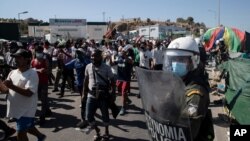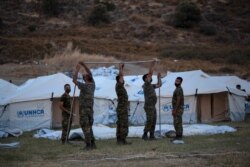The U.N. refugee agency is calling for long-term solutions for thousands of migrants on Greek islands who were rendered homeless by fires that devastated the Moria asylum center on the island of Lesbos.
An estimated 11,500 asylum seekers are living in the open since a series of fires, which started five days ago, ravaged Greece’s Moria asylum center.
No casualties have been reported, but the blaze destroyed everything, leaving everyone without shelter.
The U.N. refugee agency reports thousands of vulnerable people, including very young children, pregnant women, elderly people and people with disabilities, are sleeping in the streets, fields, and beaches.
UNHCR spokeswoman Shabia Mantoo says her agency is helping Greek authorities protect and assist asylum seekers affected by the fires. She says the UNHCR is providing emergency aid to ensure people do not sleep in the open.
“The coronavirus pandemic also is adding to an already desperate situation. People tested positive [for] COVID need to be provided with special care, isolation and treatment arrangements and medical support. The UNHCR has advised all those previously staying in the center to restrict their movements until temporary solutions are found,” Mantoo said.
The Moria center, Europe’s largest refugee camp, was meant to house 3,000 people. At times, the camp population in this squalid, tented settlement swelled to more than 20,000. This is a consequence of increasing numbers of people fleeing war, persecution and extreme poverty, and the refusal of other European countries to share the burden by accepting asylum seekers.
Mantoo said the situation must change because it is no longer tenable. Long-term solutions must be found for refugees and asylum seekers stuck in overcrowded, unsafe conditions on the Greek islands.
“UNHCR has long been highlighting the need to address the situation and conditions for asylum seekers on the Aegean Islands. The incidents at Moria demonstrate the long-standing need to take action to improve living conditions, alleviate overcrowding, improve security, infrastructure and access to services in all five reception centers on the Greek islands,” Mantoo said.
The U.N. refugee agency is appealing to European countries to do more to protect asylum seekers. It urges them to quickly relocate unaccompanied children and other particularly vulnerable people from their precarious situation on the islands.
The agency welcomes recent announcements by some European countries to take in unaccompanied minors and families with children from Greece.






